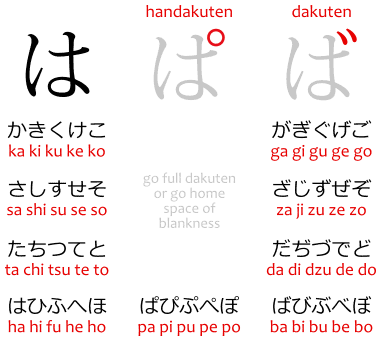In Japanese, the ゜ diacritic, called handakuten 半濁点, literally half dakuten 濁点, is used to create "semi-voiced sounds," handakuon 半濁音, which are the sounds pa-pi-pu-pe-po ぱぴぷぺぽ.
It's also called handakuonfu 半濁音符, or maru 丸, "circle," because it looks like a circle.
Usage
The handakuten is used only in kana 仮名 in the h-row to turn them into p-consonant syllables.
| Script | Without diacritic | With diacritic |
|---|---|---|
| romaji | ha-hi-fu-he-ho | pa-pi-pu-pe-po |
| hiragana | はひふへほ | ぱぴぷぺぽ |
| katakana | ハヒフヘホ | パピプペポ |
That's it. Although dakuten turns k, s, h, t into g, z, b, d, the handakuten only turns h into p.
Archaic Usage
In the past, it was used with the k-row, too. But this is not true in modern Japanese.
- ka-ki-ku-ke-ko
かきくけこ
カキクケコ - (no idea how you're supposed to pronounce this.)
か゚き゚く゚け゚こ゚
カ゚キ゚ク゚ケ゚コ゚
半濁音化
In Japanese, sometimes a suffixed morpheme gets its first syllable voiced.
- nan-hiki なんひき becomes...
nanbiki なんびき (何匹)
An unknown number of small animals.
How many small animals?
This is called rendaku 連濁, and seems to only apply to dakuten 濁点, or fully "voiced sounds," dakuon 濁音.
The same phenomenon with handakuten 半濁点, and semi-voiced syllables, would be called handakuonka 半濁音化 instead.
- nan-hatsu なんはつ becomes...
nanpatsu なんぱつ (何発)
An unknown number of shots.
How many shots?

No comments: